清华大学:《分子生物学》课程PPT教学课件(基因ene)第十八章 染色体(Chromosomes)

Chapter 18 Chromosomes 清革大当
Chapter 18 Chromosomes
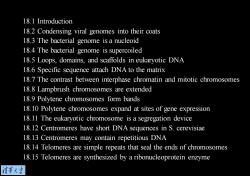
18.1 Introduction 18.2 Condensing viral genomes into their coats 18.3 The bacterial genome is a nucleoid 18.4 The bacterial genome is supercoiled 18.5 Loops,domains,and scaffolds in eukaryotic DNA 18.6 Specific sequence attach DNA to the matrix 18.7 The contrast between interphase chromatin and mitotic chromosomes 18.8 Lampbrush chromosomes are extended 18.9 Polytene chromosomes form bands 18.10 Polytene chromosomes expand at sites of gene expression 18.11 The eukaryotic chromosome is a segregation device 18.12 Centromeres have short DNA sequences in S.cerevisiae 18.13 Centromeres may contain repetitious DNA 18.14 Telomeres are simple repeats that seal the ends of chromosomes 18.15 Telomeres are synthesized by a ribonucleoprotein enzyme 情菜大兰
18.1 Introduction 18.2 Condensing viral genomes into their coats 18.3 The bacterial genome is a nucleoid 18.4 The bacterial genome is supercoiled 18.5 Loops, domains, and scaffolds in eukaryotic DNA 18.6 Specific sequence attach DNA to the matrix 18.7 The contrast between interphase chromatin and mitotic chromosomes 18.8 Lampbrush chromosomes are extended 18.9 Polytene chromosomes form bands 18.10 Polytene chromosomes expand at sites of gene expression 18.11 The eukaryotic chromosome is a segregation device 18.12 Centromeres have short DNA sequences in S. cerevisiae 18.13 Centromeres may contain repetitious DNA 18.14 Telomeres are simple repeats that seal the ends of chromosomes 18.15 Telomeres are synthesized by a ribonucleoprotein enzyme

18.1 Introduction Chromatin describes the condition of the chromosomal material during the interphase (between mitoses)of the cell cycle. Chromosome is a discrete unit of the genome carrying many genes.Each chromosome consists of a very long molecule of duplex DNA and an approximately equal mass of proteins.It is visible as a morphological entity only during cell division. Nucleoid is the compact body that contains the genome in a bacterium. Packing ratio is the ratio of the length of DNA to the unit length of the fiber containing it. 清菜大当
Chromatin describes the condition of the chromosomal material during the interphase (between mitoses) of the cell cycle. Chromosome is a discrete unit of the genome carrying many genes. Each chromosome consists of a very long molecule of duplex DNA and an approximately equal mass of proteins. It is visible as a morphological entity only during cell division. Nucleoid is the compact body that contains the genome in a bacterium. Packing ratio is the ratio of the length of DNA to the unit length of the fiber containing it. 18.1 Introduction
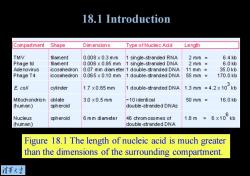
18.1 Introduction Compartment Shape Dim ensions Type of Nucleic Acid Length TMV filament 0.008×0.3mm 1 single-stranded RNA 2 mm 6.4kh Phage fd filament 0.006×0.85mm 1 single-stranded DNA 2 mm 6.0kh Adenovirus icosahedron 0.07 mm diam eter 1 double-stranded DNA 11 mm = 35.0kh Phage T4 icosahedron 0.065×0.10mm 1 double-stranded DNA 55 mm = 170.0kb 3 E.coli cylinder 1.7×0.65mm 1 double-stranded DNA 1.3 mm =4.2×10kh Mitochondrion oblate 3.0×0.5mm ~10 identical 50mm= 16.0kh (human) spheroid double-stranded DNAs Nucleus spheroid 6 mm diameter 46 chrom osomes of 1.8m 6X105kb (human) double-stranded DNA Figure 18.1 The length of nucleic acid is much greater than the dimensions of the surrounding compartment. 情菜大当
Figure 18.1 The length of nucleic acid is much greater than the dimensions of the surrounding compartment. 18.1 Introduction
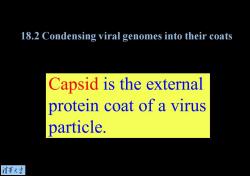
18.2 Condensing viral genomes into their coats Capsid is the external protein coat of a virus particle. 清菜大当
Capsid is the external protein coat of a virus particle. 18.2 Condensing viral genomes into their coats
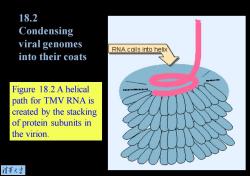
18.2 Condensing viral genomes RNA coils into helix into their coats Figure 18.2 A helical path for TMV RNA is created by the stacking of protein subunits in the virion. 情華大当
Figure 18.2 A helical path for TMV RNA is created by the stacking of protein subunits in the virion. 18.2 Condensing viral genomes into their coats

Prohead I has protein core Prohead I 18.2 Condensing viral genomes into their coats Prohead ll is empty DNA packaging begins Figure 18.3 Maturation of phage lambda passes through several Grizzled particle is part full with expanded head shell Mature phage particle stages.The empty head changes shape and expands when it becomes filled with DNA.The Black particle has full head electron micrographs show the particles at the start and end of the maturation pathway. Tail is attached Photographs kindly provided by A.F.Howatson. 清苇大当
Figure 18.3 Maturation of phage lambda passes through several stages. The empty head changes shape and expands when it becomes filled with DNA. The electron micrographs show the particles at the start and end of the maturation pathway. Photographs kindly provided by A. F. Howatson. 18.2 Condensing viral genomes into their coats
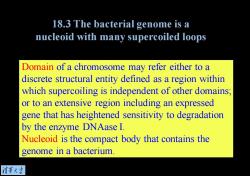
18.3 The bacterial genome is a nucleoid with many supercoiled loops Domain of a chromosome may refer either to a discrete structural entity defined as a region within which supercoiling is independent of other domains; or to an extensive region including an expressed gene that has heightened sensitivity to degradation by the enzyme DNAase I. Nucleoid is the compact body that contains the genome in a bacterium. 清菜大学
Domain of a chromosome may refer either to a discrete structural entity defined as a region within which supercoiling is independent of other domains; or to an extensive region including an expressed gene that has heightened sensitivity to degradation by the enzyme DNAase I. Nucleoid is the compact body that contains the genome in a bacterium. 18.3 The bacterial genome is a nucleoid with many supercoiled loops

18.3 The bacterial genome is a nucleoid with many supercoiled loops Figure 18.4 A thin section shows the bacterial nucleoid as a compact mass in the center of the cell.Photograph kindly provided by Jack Griffth. 清苇大当
Figure 18.4 A thin section shows the bacterial nucleoid as a compact mass in the center of the cell. Photograph kindly provided by Jack Griffith. 18.3 The bacterial genome is a nucleoid with many supercoiled loops
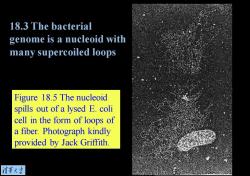
18.3 The bacterial genome is a nucleoid with many supercoiled loops Figure 18.5 The nucleoid spills out of a lysed E.coli cell in the form of loops of a fiber.Photograph kindly provided by Jack Griffith. 情華大当
Figure 18.5 The nucleoid spills out of a lysed E. coli cell in the form of loops of a fiber. Photograph kindly provided by Jack Griffith. 18.3 The bacterial genome is a nucleoid with many supercoiled loops
按次数下载不扣除下载券;
注册用户24小时内重复下载只扣除一次;
顺序:VIP每日次数-->可用次数-->下载券;
- 清华大学:《分子生物学》课程PPT教学课件(基因ene)第十七章 DNA的重新排列(Rearrangement of DNA).ppt
- 清华大学:《分子生物学》课程PPT教学课件(基因ene)第十六章 逆转录病毒和逆转座子(Retroviruses and retroposons).ppt
- 清华大学:《分子生物学》课程PPT教学课件(基因ene)第十五章 转座子(Transposons).ppt
- 清华大学:《分子生物学》课程PPT教学课件(基因ene)第十四章 重组和修复(Recombination and repair).ppt
- 清华大学:《分子生物学》课程PPT教学课件(基因ene)第十三章 DNA复制(DNA replication).ppt
- 清华大学:《分子生物学》课程PPT教学课件(基因ene)第十二章 复制子(The replicon).ppt
- 清华大学:《分子生物学》课程PPT教学课件(基因ene)第十一章 噬菌体的战略(Phage strategies).ppt
- 清华大学:《分子生物学》课程PPT教学课件(基因ene)第十章 操纵子(The operon).ppt
- 清华大学:《分子生物学》课程PPT教学课件(基因ene)第九章 转录(Transcription).ppt
- 清华大学:《分子生物学》课程PPT教学课件(基因ene)第八章 蛋白质定位(Protein localization).ppt
- 清华大学:《分子生物学》课程PPT教学课件(基因ene)第七章 遗传密码的利用(Using the genetic code).ppt
- 清华大学:《分子生物学》课程PPT教学课件(基因ene)第六章 蛋白质合成(Protein synthesis).ppt
- 清华大学:《分子生物学》课程PPT教学课件(基因ene)第五章 信使RNA(Messenger RNA).ppt
- 清华大学:《分子生物学》课程PPT教学课件(基因ene)第四章 簇和重复(Clusters and repeats).ppt
- 清华大学:《分子生物学》课程PPT教学课件(基因ene)第三章 有多少基因(How many genes are there).ppt
- 清华大学:《分子生物学》课程PPT教学课件(基因ene)第二章 从基因到基因组(From Genes to Genomes).ppt
- 清华大学:《分子生物学》课程PPT教学课件(基因ene)第一章 基因是DNA(Genes are DNA).ppt
- 清华大学:《分子生物学》课程PPT教学课件(基因ene)绪论 Molecular Biology(主讲:王钊).ppt
- 河北农业大学:《分子生物学》课程教学资源(PPT课件)第十二章 免疫多样性产生的机制.ppt
- 河北农业大学:《分子生物学》课程教学资源(PPT课件)第十一章 病毒的分子生物学.ppt
- 清华大学:《分子生物学》课程PPT教学课件(基因ene)第十九章 核小体(Nucleosomes).ppt
- 清华大学:《分子生物学》课程PPT教学课件(基因ene)第二十章 转录的起始(Initiation of transcription).ppt
- 清华大学:《分子生物学》课程PPT教学课件(基因ene)第二十一章 转录的调控(Regulation of Transcription).ppt
- 清华大学:《分子生物学》课程PPT教学课件(基因ene)第二十二章 核的剪切(Nuclear splicing).ppt
- 清华大学:《分子生物学》课程PPT教学课件(基因ene)第二十三章 催化RNA(Catalytic RNA).ppt
- 清华大学:《分子生物学》课程PPT教学课件(基因ene)第二十四章 免疫多样性(Immune diversity).ppt
- 清华大学:《分子生物学》课程PPT教学课件(基因ene)第二十五章 蛋白质间的开放交通(Protein trafficking).ppt
- 清华大学:《分子生物学》课程PPT教学课件(基因ene)第二十六章 信号的传输(Signal transduction).ppt
- 清华大学:《分子生物学》课程PPT教学课件(基因ene)第二十七章 细胞循环和生长调控(Cell cycle and growth regulation).ppt
- 清华大学:《分子生物学》课程PPT教学课件(基因ene)第二十八章 致癌基因和癌症(Oncogenes and cancer).ppt
- 清华大学:《分子生物学》课程PPT教学课件(基因ene)第二十九章 梯度、级联和发信号的途径(Gradients, cascades, and signaling pathways).ppt
- 四川大学:《植物生物学》课程教学资源(教案讲义)第一章 植物的细胞和组织.pdf
- 四川大学:《植物生物学》课程教学资源(教案讲义)第二章 植物体的形态结构和发育.pdf
- 四川大学:《植物生物学》课程教学资源(教案讲义)第三章 植物的无机营养.pdf
- 四川大学:《植物生物学》课程教学资源(教案讲义)第四章 光合作用.pdf
- 四川大学:《植物生物学》课程教学资源(教案讲义)第五章 植物的繁殖.pdf
- 四川大学:《植物生物学》课程教学资源(教案讲义)第六章 植物的生长发育及其调控.pdf
- 四川大学:《植物生物学》课程教学资源(教案讲义)第七章 生物多样性和植物的分类及命名.pdf
- 四川大学:《植物生物学》课程教学资源(教案讲义)第八章 藻类植物.pdf
- 四川大学:《植物生物学》课程教学资源(教案讲义)第九章 苔藓植物.pdf
